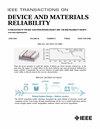Resistive Defect Analysis and Fault Modeling of DICE Memory in Commercial 40-nm CMOS Technology
IF 2.3
3区 工程技术
Q2 ENGINEERING, ELECTRICAL & ELECTRONIC
IEEE Transactions on Device and Materials Reliability
Pub Date : 2025-03-26
DOI:10.1109/TDMR.2025.3573599
引用次数: 0
Abstract
The complex architecture of double interlocked storage cell (DICE) static random access memories (SRAM), which consists of 12 Metal Oxide Semiconductor Field Effect Transistors (MOSFETs), presents challenges in manufacturing test. Manufacturing defects can cause faults in DICE SRAMs, and undetected faults may lead to test escapes, resulting in early in-field failures. These issues can prevent DICE SRAMs from meeting the applications requiring high quality in sectors such as aerospace. This paper proposes a new type of SEU fault for DICE SRAM, analyzing how physical defects influence its SEU resilience, which forms a new fault space together with parameter faults and functional faults.This paper presents a detailed analysis and fault modeling of resistive defects that may occur in DICE SRAMs and proposes a novel test algorithm to enhance fault coverage and reduce test escapes during manufacturing test. First, we define and classify the fault space, including functional faults, parameter faults, and single event upset (SEU) faults, and outline the methodology to validate faults within this space. Next, we inject resistive defects into the SPICE netlist of DICE SRAMs, conduct SPICE simulation, and inspect its corresponding behavior. Furthermore, through the analysis of the fault modeling results of DICE SRAMs and evaluating the test coverage and limitations of existing test solutions, we propose a new test algorithm. This results in a substantial increase in dynamic fault coverage from 20.57% to 28.37% and an overall improvement in fault coverage from 33.88% to 39.89% when compared to the March C+ algorithm, while reducing the possibility of test escape for parameter faults (including HSNM and RSNM faults) and SEU faults. In summary, the findings of the paper are effective in detecting the realistic faults in DICE SRAMs, thereby bolstering the effectiveness of DICE SRAMs test for critical applications.商用40纳米CMOS技术中DICE存储器的电阻性缺陷分析与故障建模
双联锁存储单元(DICE)静态随机存取存储器(SRAM)由12个金属氧化物半导体场效应晶体管(mosfet)组成,其复杂的结构给制造测试带来了挑战。制造缺陷可能导致DICE sram出现故障,而未检测到的故障可能导致测试逃逸,从而导致早期现场故障。这些问题可能会阻止DICE sram满足航空航天等部门对高质量的应用要求。本文针对DICE SRAM提出了一种新的单单元故障类型,分析了物理缺陷对其单单元弹性的影响,与参数故障和功能故障共同构成了一个新的故障空间。本文对DICE sram中可能出现的电阻性缺陷进行了详细的分析和故障建模,并提出了一种新的测试算法,以提高故障覆盖率和减少制造测试中的测试逃逸。首先,对故障空间进行了定义和分类,包括功能故障、参数故障和单事件故障,并概述了在该空间内验证故障的方法。接下来,我们将电阻性缺陷注入DICE sram的SPICE网络列表中,进行SPICE仿真,并检测其相应的行为。此外,通过分析DICE sram的故障建模结果,评估现有测试方案的测试覆盖率和局限性,提出了一种新的测试算法。与March C+算法相比,动态故障覆盖率从20.57%大幅提高到28.37%,总体故障覆盖率从33.88%提高到39.89%,同时降低了参数故障(包括HSNM和RSNM故障)和SEU故障的测试逃逸可能性。综上所述,本文的研究结果有效地检测了DICE sram中的实际故障,从而提高了DICE sram测试在关键应用中的有效性。
本文章由计算机程序翻译,如有差异,请以英文原文为准。
求助全文
约1分钟内获得全文
求助全文
来源期刊

IEEE Transactions on Device and Materials Reliability
工程技术-工程:电子与电气
CiteScore
4.80
自引率
5.00%
发文量
71
审稿时长
6-12 weeks
期刊介绍:
The scope of the publication includes, but is not limited to Reliability of: Devices, Materials, Processes, Interfaces, Integrated Microsystems (including MEMS & Sensors), Transistors, Technology (CMOS, BiCMOS, etc.), Integrated Circuits (IC, SSI, MSI, LSI, ULSI, ELSI, etc.), Thin Film Transistor Applications. The measurement and understanding of the reliability of such entities at each phase, from the concept stage through research and development and into manufacturing scale-up, provides the overall database on the reliability of the devices, materials, processes, package and other necessities for the successful introduction of a product to market. This reliability database is the foundation for a quality product, which meets customer expectation. A product so developed has high reliability. High quality will be achieved because product weaknesses will have been found (root cause analysis) and designed out of the final product. This process of ever increasing reliability and quality will result in a superior product. In the end, reliability and quality are not one thing; but in a sense everything, which can be or has to be done to guarantee that the product successfully performs in the field under customer conditions. Our goal is to capture these advances. An additional objective is to focus cross fertilized communication in the state of the art of reliability of electronic materials and devices and provide fundamental understanding of basic phenomena that affect reliability. In addition, the publication is a forum for interdisciplinary studies on reliability. An overall goal is to provide leading edge/state of the art information, which is critically relevant to the creation of reliable products.
 求助内容:
求助内容: 应助结果提醒方式:
应助结果提醒方式:


